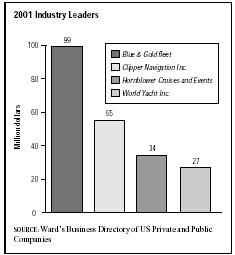SIC 4489
WATER TRANSPORTATION OF PASSENGERS, NOT ELSEWHERE CLASSIFIED
This category covers establishments primarily engaged in furnishing water transportation of passengers, not elsewhere classified.
NAICS Code(s)
483212 (Inland Water Passenger Transportation)
487210 (Scenic and Sightseeing Transportation, Water)
This industry is comprised of a number of different operations. Airboats, or swamp buggies, provide transportation primarily for sightseers in swamps and marshy areas; excursion and sightseeing boats offer passenger tours and non-deep water cruises; canal boats give passengers the opportunity to explore historic canals. In 2001, 249 establishments offered services in the inland water passenger transportation industry, employing 3,751 yearly, with an annual payroll of $121.64 million. More than half of these establishments employed fewer than five individuals, and only five employed more than 100.
Not only because of their unspoiled beauty and diversity of wildlife, but also because of their inaccessibility without the aid of a knowledgeable guide, swamps represented an ideal setting for services offering sightseeing tours on such watercraft as airboats (swamp buggies). The airboat tour industry experienced two events that have had, and will continue to have, polar impacts on the viability of the industry. First, since the vast majority of the airboat tour business in the United States is centered in Florida, the crash of ValuJet Flight 592 on May 15, 1996 brought to the nation's attention the potential importance of airboats in search-and-rescue scenarios. This is because areas such as a swamp are virtually inaccessible by other, more traditional means. Commercial airboats were among the first vehicles used to access the crash site for the rescue and evacuation of potential survivors, and eventually were used to transport various personnel to and from the site, including relatives of victims.
Conversely, the battle between environmentalists and airboat operators in Florida has been heating up.

According to the environmentalists, airboats have contributed greatly to increased ecological pressure placed on swamps—most notably, the Everglades. The intrusion of these vehicles and the sightseers they bring is causing a loss of habitat for endangered and threatened species. Environmental groups were looking to enact legislation to curtail airboat use.
By 2001, concerns over the safety of airboats was rising, as the boats were not required to carry communication radios or other tracking devices, and there were no speed limits or consistent traffic patterns. Due to the height of the native grasses in the natural area and the noise generated by the boats, it can be difficult for boats to be aware of another's presence until the boats are right next to each other. While Everglades tour boats were not supposed to detour from established routes for any reason, so that they may be found in case of trouble, there was nothing to keep a boat in trouble from unplanned drifting.
Other such businesses, however, based their tourist appeal not on remoteness from civilization, but rather on the historical connections between industry and natural or man-made waterways. Disused canals held great natural beauty, but also served as a reminder of a key moment in the nation's past (the brief and yet crucial role of canals in opening up the West and fostering the growth of the U.S. economy) and of a time when the forces of industrialization and the natural world co-existed on a more equal footing. One example was the Chesapeake and Ohio canal, connecting Cumberland, Maryland, and Washington, D.C. The canal became a historic park, thanks in part to the efforts of Supreme Court Justice William O. Douglas, who successfully opposed plans to turn the route into a scenic autoway.
The nation's excursion boat business continued to expand, offering the public activities ranging from dinner yacht cruises and steamboat rides to canal cruises, charter canal boats, and even rides on official U.S. Mail boats. Riverboat rides continued to be popular on river ports, especially throughout the Mississippi/Missouri/Ohio River systems and in the Tennessee River Valley.
Additionally, many individuals were seeking to explore shipwrecks, initially protected on account of their historical significance. These wreck sites have become "bottomland preserves," providing additional sources of tourist revenue for local businesses offering water transportation services shuttling tourist, marine biologists, and scuba enthusiasts to and from sites.
According to the U.S. Transportation Institute's Industry Profile, as of July 2002, riverboat gambling operations were state-authorized in Indiana and Iowa, cumulatively operating approximately 20 self-propelled vehicles. There were an additional 26 U.S. flag "cruise-to-nowhere" gaming vessels, which were primarily located in Florida. There also were traditional steamboats offering cruises on the Mississippi and Ohio Rivers. The Delta Queen Steamship Company, for instance, was operating three paddlewheel steamboats.
As of 2001, the industry leader was San Francisco-based Blue & Gold Fleet, with $99 million in revenue and 400 employees. The company operated passenger service to tourists in the Bay Area, particularly to Alcatraz Island. In second place was Clipper Navigation of Seattle, with $55 million in revenue and 200 employees. Like Blue & Gold, Clipper Navigation catered to the tourist industry, but its market was the Pacific Northwest, including Vancouver. Other industry leaders were San Diego-based Hornblower Cruises and Events, with $34 million in revenue, and New York-based World Yacht Inc. with $27 million in revenue.
Further Reading
"About Us." Blue & Gold Fleet, 12 February 2004. Available from http://www.blueandgoldfleet.com
Baker, Deborah J., ed. Ward's Business Directory of US Private and Public Companies. Detroit, MI: Thomson Gale, 2003.
DeMarzo, Wanda J. "Few Rules Govern Airboats in Glades, Fla." Knight Ridder/Tribune Business News, 26 August 2001.
The Transportation Institute. Industry Profile: 2004. 20 March 2004. Available from http://www.trans-inst.org .
U.S. Census Bureau. County Business Patterns 2001. 20 March 2004. Available from http://www.census.gov .
"Welcome Aboard." Victoria Clipper. 22 March 2004. Available from http://www.victoriaclipper.com .
Comment about this article, ask questions, or add new information about this topic: